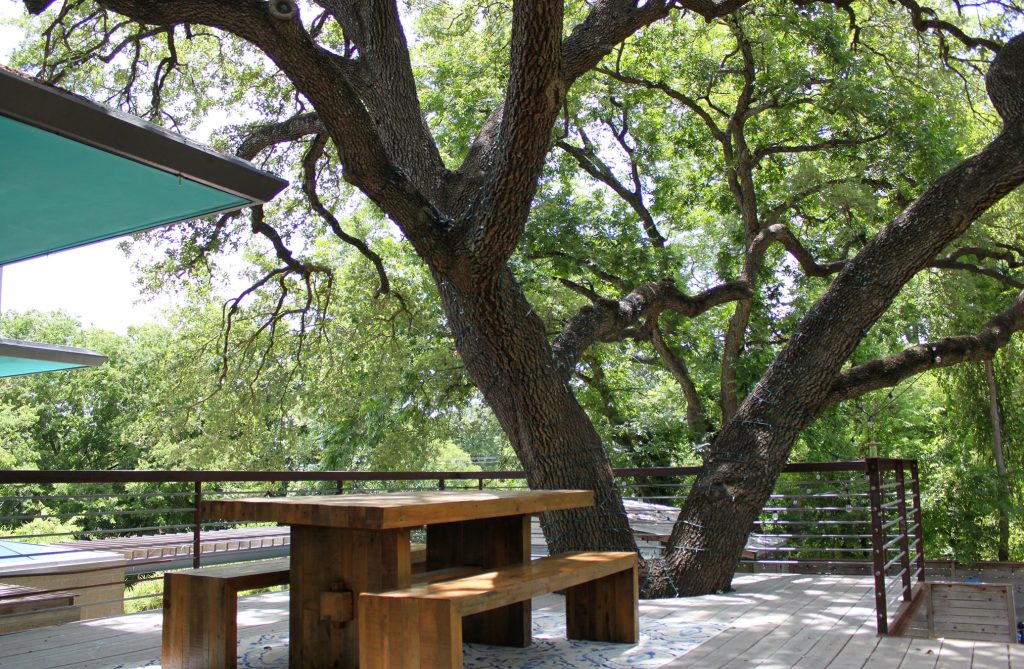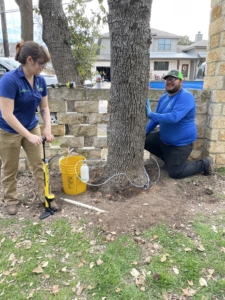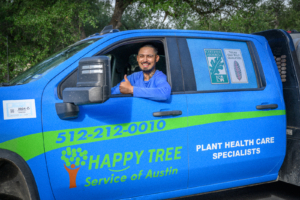Georgetown Tree Service & Certified Arborist | Tree Experts For Caring And Healthcare
- Tree Removal, Tree Planting, and Tree Trimming
- Certified Arborists
- Emergency Services
Call Today to Schedule an Appointment. 512-212-0010
Call Today to Schedule an Appointment. 512-212-0010
Georgetown’s trees are as diverse and historic as the community itself. From towering live oaks shading century-old neighborhoods to younger, fast-growing species in newly built subdivisions, each property has its own tree care needs. But with Georgetown’s unique soil composition, drought stress, and the ongoing threat of oak wilt, maintaining a healthy canopy takes more than routine upkeep. It requires expertise rooted in Central Texas biology—and a proactive approach to tree healthcare inspections and long-term safety.
That’s where Happy Tree Service of Austin comes in. As a trusted commercial tree service company, we provide certified, science-backed tree care to residential, commercial, and HOA properties throughout Georgetown and the surrounding areas. Whether you’re managing storm recovery, preparing for spring growth, or planting for the future, our team helps you make informed, confident decisions about your trees—no shortcuts, just long-term care.

At Happy Tree Service of Austin, we combine extensive experience with the highest industry standards. Our qualifications reflect a commitment to doing tree care the right way—safely, responsibly, and with the health of Georgetown’s canopy in mind.
Every project in Georgetown begins with a credentialed expert on site. Our team includes ISA certified arborists who have spent decades working with Central Texas tree species and soil conditions. We understand the biology behind each cut, the timing required to minimize stress, and the methods that promote resilience instead of regrowth chaos. This deep local experience allows us to deliver consistently safe, effective, and forward-thinking care—whether we’re restoring storm-damaged canopies or planning new installations.
Oak wilt is one of the most destructive tree diseases in the Austin Metro, and Georgetown is firmly within its reach. Our team includes Texas Oak Wilt Qualified professionals who are trained to identify early signs of infection and apply containment strategies that protect surrounding trees. We are also Tree Risk Assessment Qualified (TRAQ), which means we can evaluate trees not just for current health, but for future risk—an essential service in a region where high winds and shallow roots can lead to unexpected hazards.
We don’t rely on guesswork. Happy Tree’s arborists use diagnostic tools, soil testing, and industry-standard pruning protocols to ensure every decision is backed by evidence. From crown structure to soil compaction, our recommendations are tailored to the biological needs of each tree and the environmental realities of Williamson County.
We believe expert tree care should come with clear communication, clean job sites, and respect for your time. Whether you manage a multi-acre estate or a compact backyard, our team shows up prepared, answers your questions, and focuses on long-term solutions. Many of our clients have trusted us for years because we don’t just complete a task—we build partnerships grounded in service and accountability.
In a place like Georgetown, where trees face seasonal storms, drought stress, and crowding from construction, pruning is more than a routine service—it’s an essential investment in safety and resilience. Our team—and our reputation as a skilled tree trimming service company—uses species-specific techniques to support structural health while protecting each tree’s natural form.
Removing the right limbs in the right places helps trees withstand wind, grow in balance, and reduce risk over driveways, fences, or walkways. We evaluate each tree’s canopy for overgrowth, weight distribution, and attachment strength before making any cuts. Crown thinning improves airflow and allows more light to reach lawns and understory plants, while structural shaping helps younger trees develop strong, storm-ready frameworks.
Timing matters just as much as technique. In Georgetown, spring and fall bring unpredictable weather patterns that test every branch. We prune during windows that support recovery and reduce the risk of disease, aligning our work with the tree’s natural growth cycle. Seasonal pruning helps prevent limb drop and minimizes breakage during high winds or storms.
Live oaks, cedar elms, pecans, and ornamental trees all respond differently to pruning. We adjust our methods based on the biology of each species and its location—whether it’s a solitary tree in a field or part of a dense urban canopy. Understanding these differences is critical to preventing unnecessary stress and promoting lasting vitality.
Not all trimming is helpful. Over-pruning methods like topping or lion-tailing—where inner branches are stripped away—can permanently weaken a tree. We strictly follow ANSI A300 pruning standards to ensure every cut supports health rather than harm. Our goal is to protect the canopy, not disfigure it.
 Tree Removal and Emergency Response With Safety in Mind
Tree Removal and Emergency Response With Safety in MindWhen a tree becomes unstable, diseased, or structurally compromised, removal may be the only safe option. In Georgetown’s growing neighborhoods and commercial corridors, this work often happens near buildings, sidewalks, or utility lines—requiring careful planning and precise execution. That’s why homeowners and businesses alike turn to us as their trusted tree removal company.
Our certified arborists begin with a thorough assessment of the tree’s condition, root system, lean, and proximity to structures. We identify internal decay, fungal presence, or storm-related splits that compromise the tree’s integrity. If removal is warranted, we create a site-specific plan to protect surrounding trees and hardscapes.
We use advanced rigging techniques and sectional dismantling to remove large trees without causing damage to nearby lawns, patios, or irrigation systems. Our crews are trained to work in tight urban lots, sloped yards, and busy commercial areas with minimal disruption.
Storm damage can cause trees to split, uproot, or drop heavy limbs without warning. We offer emergency response for homeowners and property managers dealing with fallen or unstable trees. Our team prioritizes safety, clears debris, and ensures structures are protected during the process.
Tree removal isn’t complete until the site is clean and safe. We remove all large debris, chip branches as needed, and inspect nearby trees for hidden damage. When requested, we coordinate stump grinding or site restoration to leave the area ready for its next use.
Tree removal often leaves behind more than a memory—it leaves behind a stump that can attract pests, sprout regrowth, or obstruct landscaping plans. We offer full-service stump grinding for both surface-level and below-grade removal, ensuring a clean slate for whatever comes next.
Depending on your goals, we can grind stumps flush with the ground or several inches below grade. This allows for easy lawn restoration, replanting, or hardscape installation. Our equipment fits most residential and commercial spaces, even those with limited access.
Stumps left untreated may sprout shoots or harbor insects like carpenter ants or termites. Grinding eliminates this risk by destroying the root flare and cutting off the source of nutrients. It’s the final step in truly removing a tree from your landscape.
Whether you’re replanting a tree, installing a patio, or just want to mow the lawn without navigating an obstacle, stump grinding improves both the look and function of your yard. We clean up the mulch created during grinding or leave it for your reuse—it’s your choice.
Planting a tree is an investment that should last for decades—but only if it’s done correctly from the beginning. In Georgetown, poor soil conditions, drainage challenges, and harsh summer heat mean trees need thoughtful planning and proper post-planting care to survive and thrive. Our tree planting services help ensure your investment grows strong and healthy, season after season.
Not every tree will do well in Georgetown’s soil or climate. Our certified arborists help you select native or adapted species like live oaks, cedar elms, Texas redbuds, and desert willows that are known to perform well under drought conditions and soil variability. We also consider goals like shade, privacy, or seasonal color when recommending the right tree for your landscape.
Where you place a tree matters just as much as what you plant. We assess each site for factors like sun exposure, prevailing winds, drainage flow, and potential root conflicts with nearby structures. A well-placed tree won’t just grow—it will enhance your property for years to come without interfering with foundations, fencing, or irrigation systems.
One of the most common causes of tree failure is incorrect planting depth. We ensure that every tree is installed with the root flare above ground and the hole sized properly for optimal establishment. This simple step supports proper oxygen flow and reduces the risk of trunk rot or girdling roots.
After planting, we offer guidance on watering schedules, mulching, and structural support to help your tree establish a strong start. Young trees often need targeted pruning and occasional fertilization during the first few years, and we’re here to monitor and assist with that process.
 Soil-Focused Tree Healthcare: Deep Root Fertilization and Air-Spading
Soil-Focused Tree Healthcare: Deep Root Fertilization and Air-SpadingTree health begins below the surface. Many Georgetown properties—especially in newer neighborhoods—suffer from compacted, nutrient-poor, or disrupted soils that limit root function. Happy Tree uses science-based diagnostics and corrective treatments to support healthier trees from the ground up.
Our deep root fertilization services target the active root zone with a blend of slow-release nutrients designed to improve vigor, foliage density, and disease resistance. This is especially useful for trees showing signs of decline after construction or drought.
Air-spading uses compressed air to loosen compacted soil without damaging roots. This technique restores oxygen flow and water infiltration around the root system—crucial for trees planted near driveways, sidewalks, or previously disturbed ground.
We don’t guess. Our arborists combine visual assessments with lab-tested results from soil and tissue samples to create precise treatment plans. Whether your trees are suffering from iron deficiency, poor drainage, or overwatering, we tailor our approach to the actual problem—not the symptoms.
Trees in commercial courtyards, HOA entryways, or near high-use pathways face extra stress. We provide health maintenance plans that address these conditions and keep trees strong despite environmental pressure.
Oak wilt remains one of the most serious threats to Georgetown’s tree canopy. Caused by a fungal pathogen, it spreads rapidly through root systems and open pruning wounds, killing red oaks and severely weakening live oaks across entire neighborhoods if not managed early and aggressively.
Early detection is critical. Our certified arborists look for signs like veinal browning, leaf drop, and sudden canopy loss—especially in red oaks, which often serve as the first indicator of local infection. We also assess clusters of declining trees that may suggest underground transmission.
Timing matters. To reduce the risk of spreading oak wilt through open wounds, we only prune oaks during the safe window from July to January. Outside this period, pruning is only done when absolutely necessary and with immediate wound dressing to prevent insect transmission.
Happy Tree’s oak wilt qualified professionals offer a range of containment and treatment strategies based on current research and site-specific conditions. These include root trenching, systemic fungicide injections, and long-term monitoring to help preserve remaining trees and prevent the disease from spreading further.
Oak wilt doesn’t stop at your property line. We work with HOAs, adjacent homeowners, and entire communities to coordinate effective, large-scale prevention plans. Education and consistency are key when protecting neighborhoods with shared root systems and mature oak populations.
We understand the challenges that commercial property managers, HOA boards, and developers face when managing tree care across multiple buildings, common areas, and entryways. Our team provides scalable solutions that meet safety standards, keep properties looking their best, and reduce long-term liability.
Routine inspections and seasonal trimming keep canopies healthy and reduce the risk of falling limbs or disease outbreaks. We work with each client to build a maintenance plan that matches their property layout, tree inventory, and budget.
Trees located near sidewalks, parking lots, or playgrounds may require added structural support. We install cabling and bracing systems to reinforce weak branches or codominant trunks—helping preserve high-value trees while keeping common areas safe.
After high winds or extreme weather, our crews are ready to assess tree damage, remove hazards, and document risk levels for liability protection. We also provide tree risk reports to support insurance claims or city compliance.
We make reporting easy. Our team delivers written estimates, service summaries, and follow-up recommendations after every job—making it simple for property managers to share updates with HOA boards or ownership groups.
Healthy trees require more than seasonal attention—they need expert care grounded in science, safety, and experience. Whether you’re restoring storm damage, addressing oak wilt, or planning a long-term maintenance schedule, Happy Tree Service of Austin is here to help.
Our ISA Certified Arborists offer free on-site estimates for homeowners, business owners, and property managers across Georgetown and Williamson County. Call today to schedule a consultation with our certified team and get the tree care your property deserves.